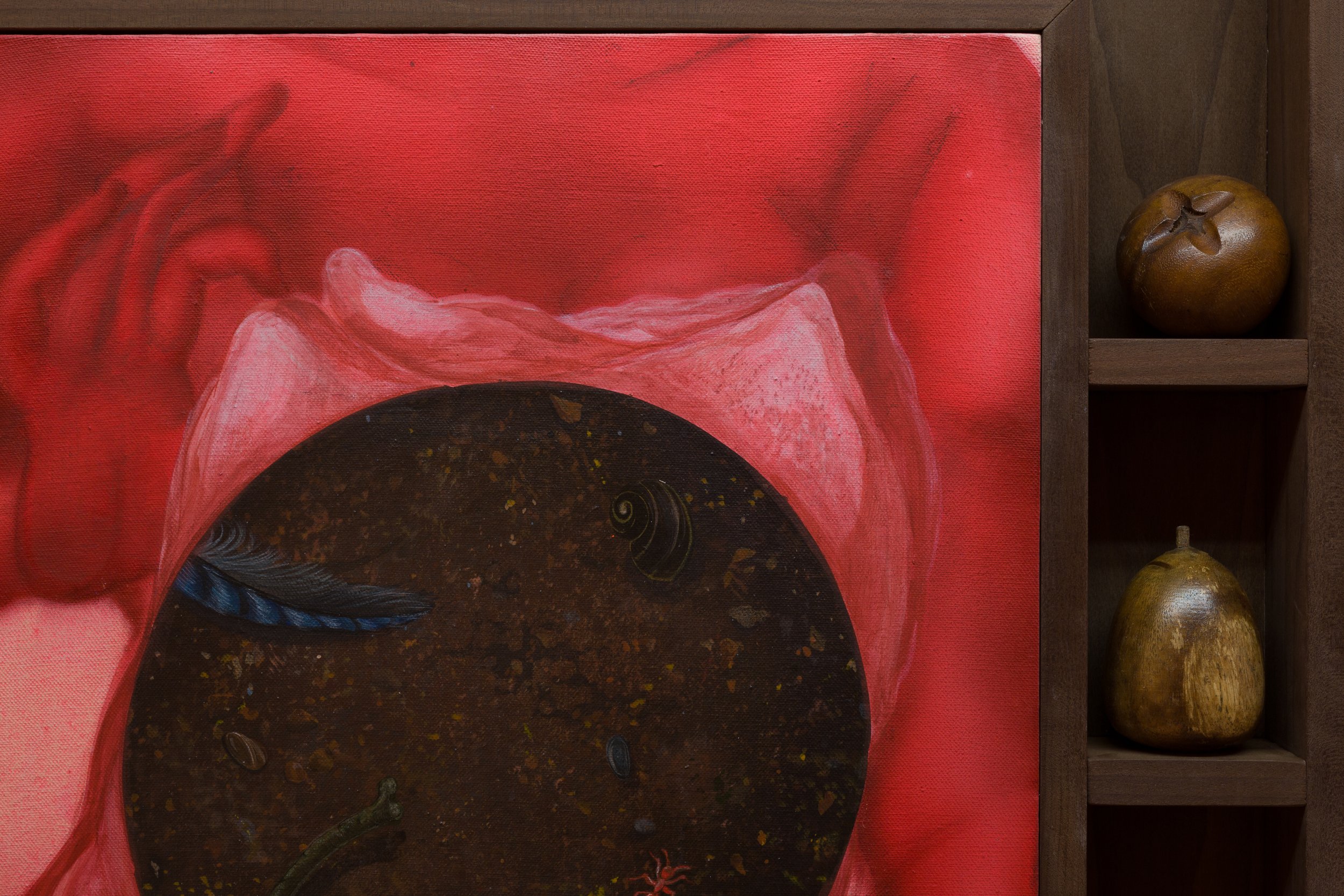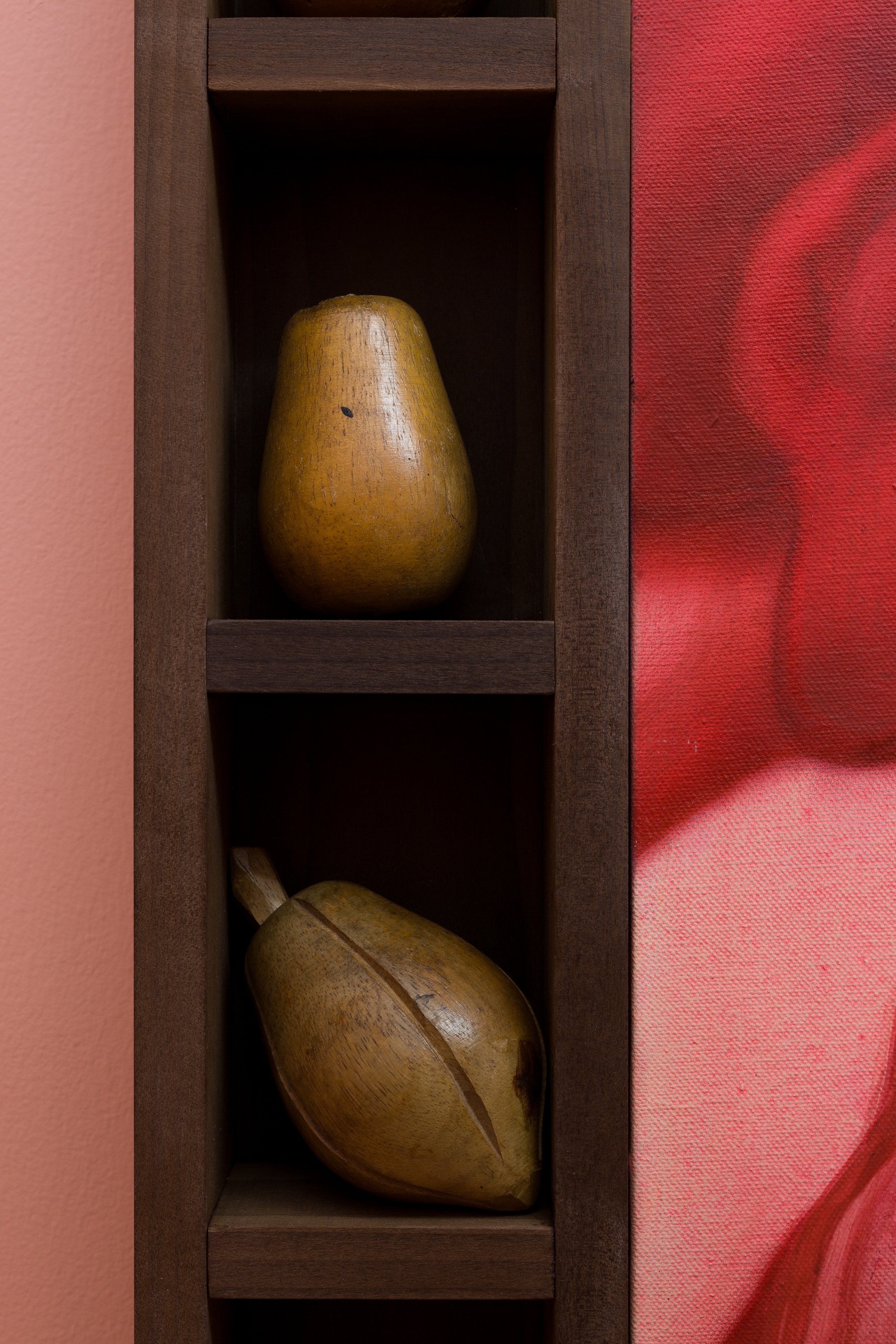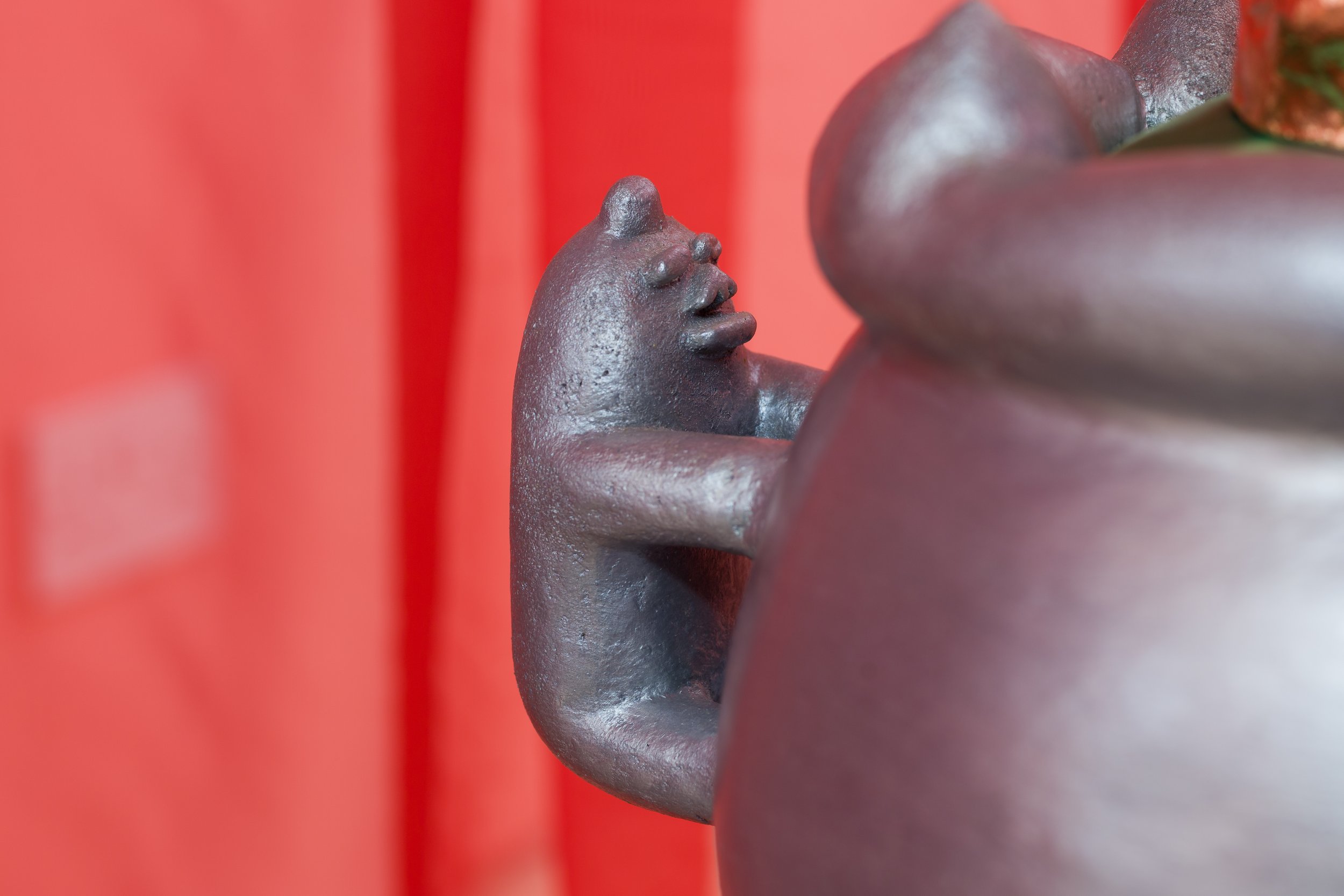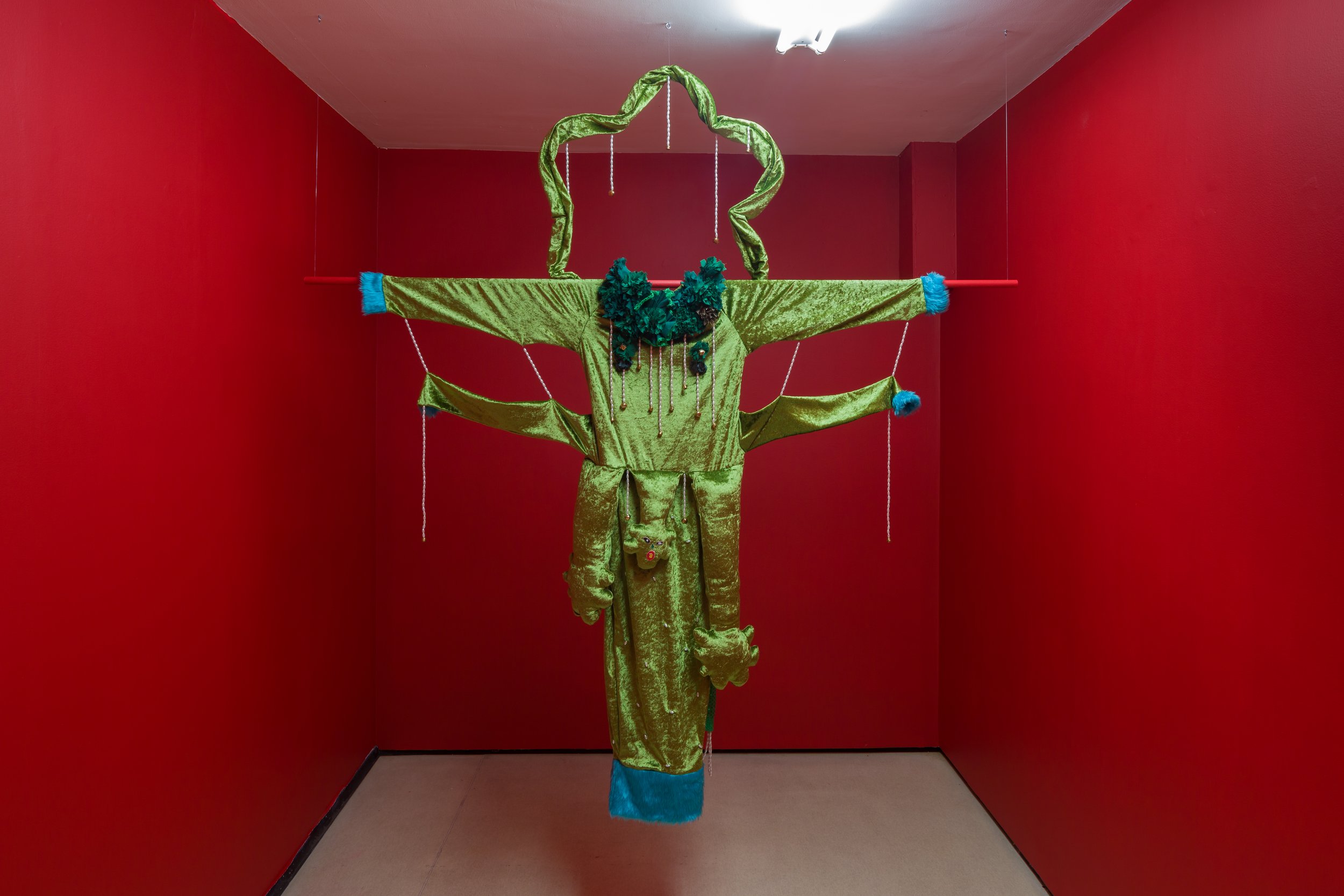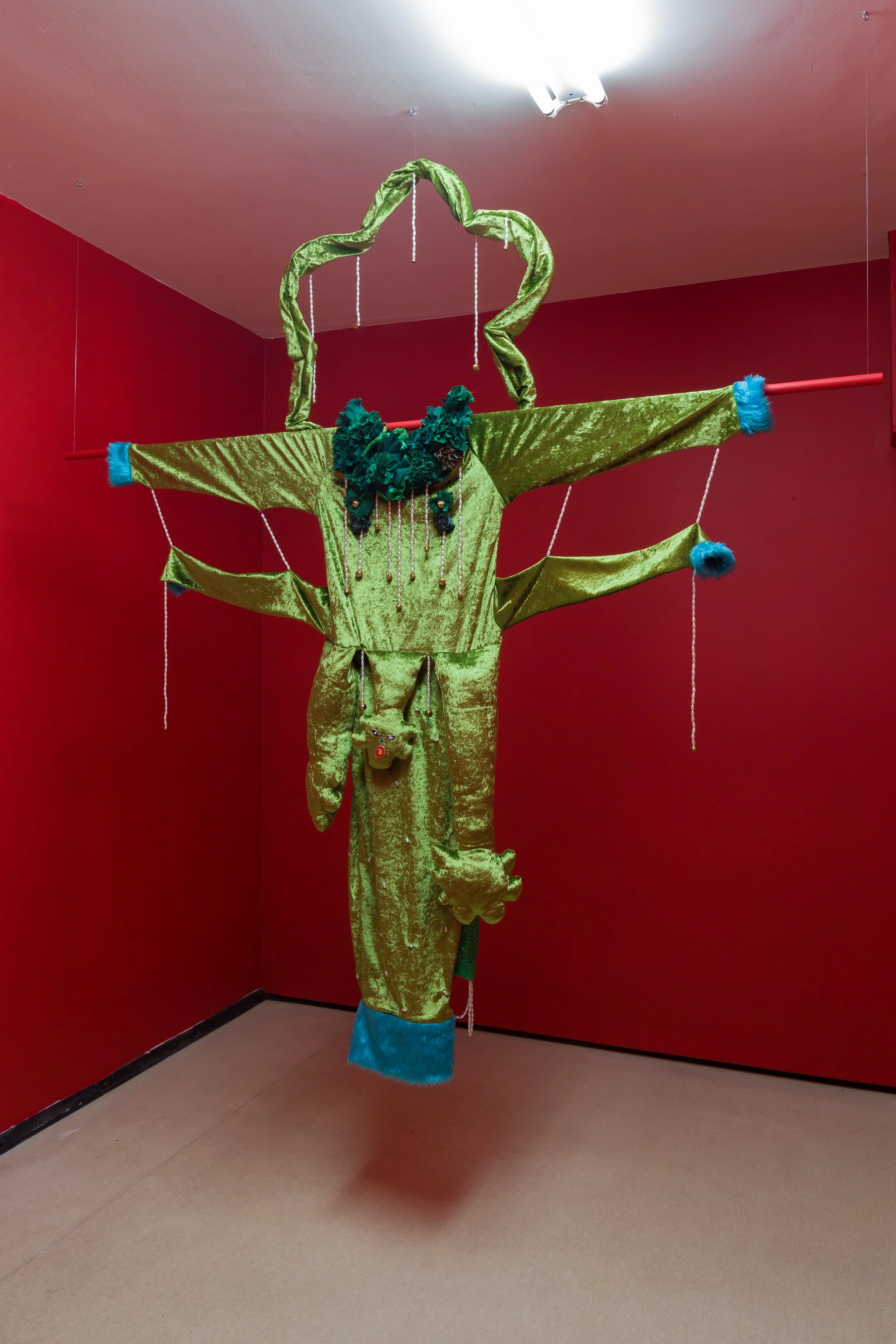WORMB weaves together the work of Rosie Vohra and Rae-Yen Song, in a space coloured with a flushed, bloody palette of venous reds and pulpy pinks. This is a bodily space of sinuous, gauzy curtain-like membranes, in which an array of paintings, objects, artefacts and images serve as windows to fleeting situations or entire other worlds.
One such world can be seen in Rae-Yen Song’s large lenticular print, song dynasty ○○. It is a world in which we cannot rely solely on our eyes to tell us the truth of a situation. The costumed characters in the image - viewed from one angle - stand unyielding before our gaze; but with a slight shift in our viewpoint, they escape us. These characters are flanked by ah kong ╌soul╌ - a pair of two-faced ceramic guardians. Their mouths are wide open - ready to give, or to receive; to suck you in or spit you out. In another life, these custodians have been earth-bound, shoe-like, looking upwards. Here, their flat soles become backs-to-the-wall, and their watchfulness pivots outwards - a rapid 90-degree shift. In this world, things can quickly oscillate, rotate, mutate; what was once beneath us now lies ahead, or perhaps the sky has fallen. Disorientation is baked in, by design.
To see in multiple directions or multiple dimensions is to occupy a space of transition, to stand on a threshold between one place and another. WORMB can be thought of as a series of such openings; the works are portals. Passing through a perforation in a gauzy membrane, we look through another opening - a stone archway in Vohra’s Creepers. Two figures are spotted emerging from the stonework, creeping by daylight, in consort. The scale of the painting somehow complicates the sense of levity that might inhere in a smaller image. The creepers are caught in the attempt to cross an unspecified boundary, imperceptibly - a silent evasion.
Elsewhere, in Who says words with my mouth, Vohra takes us across another, bodily, boundary. A human female abdomen is peeled open - another portal - to reveal a muddy patch, home to a snail, an ant, a lichen-covered branch, shells, stones. The usually unseeable interior of one body is revealed to be the entire world of other bodies within; that fleshy peeling-back, reminiscent of a magnolia flower, invokes thoughts of symbiotic stagings, of alternative viewpoints, and of scalar shifts - zooming in and zooming out.
Vohra’s painting is framed by stained tulipwood and darkened fruits, drawing our gaze down, earthwards, to where critters crawl and things grow and decay. Here, in WORMB’s worm-womb, we can imagine long soft bodies quietly eating and excreting the ground beneath our feet, reconditioning the earth, restoring fertility to support new life. Song also brings us to the ground, with a small family of familiar mushroom-like growths, ✵may-may songuu✵. Suggestions of smiles play across the lips which Song has given them. Perhaps they know that they are merely the ephemeral fruits of a much larger subterranean network, a vast mycelial growth absorbing nutrients from decaying matter, drawing life from death. They are their own ancestry. The base of the mushroom is another portal, to a supporting otherworld.
Our eye is drawn to the earth, but elsewhere, we are the object of that same downwards gaze, subjected to the scrutiny of Song’s scowling clouds. This renders us the critters, the crawlers, the creepers. Song imagines these clouds as heavenly bodies, ancestral emissaries; a drifting, intangible presence in the cycle of life and death, passing judgement on those below. We are caught somewhere in the middle, looking up and down, all the while enclosed in that fleshy interior.
The centre of this interior is lined with another bulging red membrane. It houses Song’s vessel, pot. The vessel has a taught, bulbous belly, and has borne a preciously symbolic object. But its spout is decidedly phallic, making this pot both male and female at the same time; or, more likely, neither, or something else quite beyond. We have seen the vessel’s lustrous contents before; it resembles those open-mouthed guardians. There is a genealogy at play here, but the nature of relations is hard to determine.
That genealogy also hangs with a costume, stilled. We’ve seen ºvegetableº before, too, in Song’s lenticular print; but is it quite the same? We might go back and check, but that image was elusive anyway, resisting interrogation. Just as bodies slip from that image, so one has slipped from this costume, leaving us to question who it was for, and who might wear it again. Arms outstretched, it blocks our way; but there is no way, just a dead end. Perhaps the costume itself is the means of escape; perhaps the outstretched arms beckon rather than block, inviting us to look through another window and gaze upon an unreachable enclave.
Finally, with further outstretched limbs and another bulbous abdomen, a Bembidion laetum beetle is painted large - really large - pushing at the limits of Vohra’s canvas. Two human figures hang from its legs. They are dwarfed by the beetle, but swing, acrobatically, balanced in the symmetry of the composition. Quite what the beetle might gain from their presence is uncertain, but some kind of symbiotic equilibrium can be imagined. The human figures are informed by a 19th century woodcut of a circus scene by Shri Nrityalal Datta, engraved in Kolkata. The ancestors, cavorting, are looking down here, too.
The icons of this painting are flatly executed within the plane of the picture; an assumed three-dimensional space seems not to reveal itself through perspective. The beetle could be trapped, or preserved, or it could be that our field of vision is too limited to see quite where this ancient being is going. Perhaps it is crawling, imperceptibly, back towards the belly of that magnolia-flower-peeling-back. The ancient magnolia, after all, pre-dates the emergence of the bee; its robust female reproductive organs are thought to have evolved to sustain pollination by beetles. The cycle continues, and we go round again.
Written by Michael Barr
Rosie Vohra (b. 1992, Hertfordshire, UK) is a multi-disciplinary artist based in Leeds. She studied at The Royal Drawing School in 2014, after receiving a BA in Fine Art at Leeds Arts University in 2013. Recent solo and group exhibitions include: Definitions of Drawing, Sunny Bank Mills, Leeds (2021); Armley Horses public sculpture, Gotts Park, Leeds (2021); Chrysalis, Hyde Park Art Club, Leeds (2021); Canopy Kilt (solo show), Proudick Gallery, London (2019); Post Curse, Freehold Projects Space, Leeds (2019); The Sir Denis Mahon exhibition, The British Museum, London (2018); Social Event, Platform, Glasgow International Festival (2018).
Rae-Yen Song (b. 1993, Edinburgh, Scotland) is an artist based in Glasgow. Working expansively through drawing, sculpture, installation, costume, video, sound, performance, family collaboration and any other medium that becomes appropriate, Song’s practice is a long-term exercise in self-mythology as survival tactic. It explores the position of Other within our tangled reality, speaking broadly about foreignness, identity, and what it means to belong – or not.
Song has been shortlisted for the 2022 Margaret Tait Award and is currently showing ▷▥◉▻ , a solo exhibition at Dundee Contemporary Arts (until 20/03/22). Other selected projects include: wūûūwūûū, a LUX Scotland moving image commission for BBC Scotland (2021); Fabric of Society, Glasgow International (2021); songdynasty.life, a nascent online archive, with videos commissioned by Edinburgh Art Festival and Hunterian Art Gallery (2020 - ongoing); ✵may-may songuu✵, a solo exhibition at CFCCA, Manchester (2020); Survey, Jerwood Space, London (2018); Platform, Edinburgh Art Festival (2018); Human Rights Arts Festival, JDA Perera Gallery, Colombo (2017). Recent residencies include with Talbot Rice Gallery, Edinburgh (2019-21); Hospitalfield, Arbroath (2019); Sura Madura, Sri Lanka (2017).





























